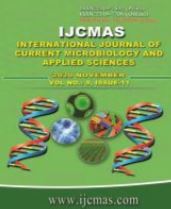


 National Academy of Agricultural Sciences (NAAS)
National Academy of Agricultural Sciences (NAAS)

|
PRINT ISSN : 2319-7692
Online ISSN : 2319-7706 Issues : 12 per year Publisher : Excellent Publishers Email : editorijcmas@gmail.com / submit@ijcmas.com Editor-in-chief: Dr.M.Prakash Index Copernicus ICV 2018: 95.39 NAAS RATING 2020: 5.38 |
Water is considered to be one of the essential resources for the survival of living beings. The vital resource is exposed to toxic pollutant due to the untreated industrial discharge from tannery, textile and other industries. Effluents discharged from the tannery and textile industries contains an ample of heavy metals and other toxic azo dyes which affects the living beings including aquatic and terrestrial flora and fauna. The removal of this toxic compounds from the water bodies has become a challenge to the human society. Various treatments are used for the removal of these toxic compounds but due to its undesirable features such as partial removal, higher maintenance cost these methods are considered as ineffective process. Microbes remain as a promising candidate in bioremediation which effectively degrade the xenobiotic component such as hexavalent chromium and toxic azo dyes completely from the environmental bodies. This review concentrates on the tannery and textile effluents and the general treatment methods used for the remediation of the effluents from these sectors.
 |
 |
 |
 |
 |